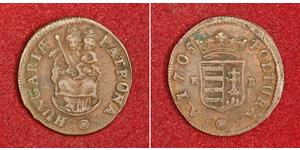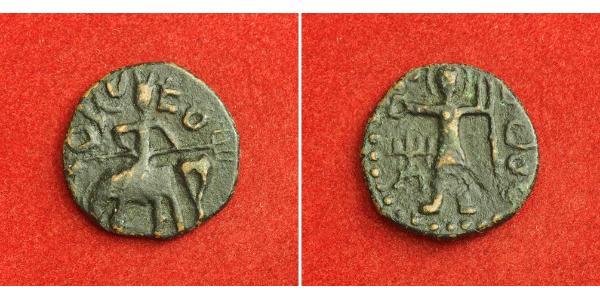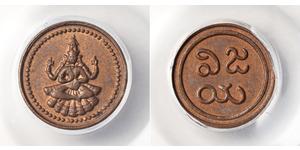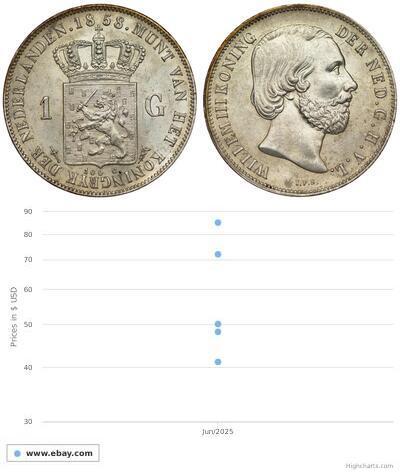(Verkauft für $16.0)
Kushan Empire, Huvishka (155-183 AD) AE Unit Coin. Elephant Rider / Miiro. VF
Ruler: Huvishka
State: Kushan Empire
Denomination: AE Unit
Region: region of Mathura
Period: late 1st Century AD
Reference: MItchiner 3269 var.
Condition: Dark deposits, ohterwise VF.
Material: Bronze
Diameter: 22mm
Weight: 6.37gm
Obverse: King, holding spear nad riding elephant right. Inscription above.
Reverse: Miiro (lunar god) standing, holding wreath and spear? Tamgha (royal monogram) of Huvishka in left field.
Huvishka ("Ooishki") was a Kushan emperor from the death of Kanishka (assumed on the best evidence available to be in 140 CE) until the succession of Vasudeva I about forty years later. His rule was a period of retrenchment and consolidation for the Empire. In particular he devoted time and effort early in his reign to the exertion of greater control over the city of Mathura. Mathura represented the southernmost extent of the Empire and, like much of the Indian Subcontinent, had been ruled via a series of subordinate rulers. These rulers, the ksatraps, maintained a certain amount of autonomy up under Kanishka, but they vanish from records in Huvishka's reign, while Huvishka patronised both Buddhist and Brahmin institutions in the town.
Huvishka was the son of Kanishka. His reign is also known as the golden age of Kushan rule. The reign of Huvishka corresponds to the first known epigraphic evidence of the Buddha Amitabha, on the bottom part of a 2nd-century statue which has been found in Govindo-Nagar, and now at the Mathura Museum. The statue is dated to "the 28th year of the reign of Huvishka", and dedicated to "Amitabha Buddha" by a family of merchants. There is also some evidence that Huvishka himself was a follower of Mahayana Buddhism. A Sanskrit manuscript fragment in the Schøyen Collection describes Huvishka as one who has "set forth in the Mahayana."
Compared to his predecessor Kanishka, Huvishka seems to rely less on Iranian deities (which are much less numerous in his coinage), and more on India ones, such as war divinities of Shivaism.
All offered coins are guaranteed to be ancient and as described.
The Kushan Empire was an empire in South Asia originally formed in the early 1st century CE under Kujula Kadphises in the territories of ancient Bactria around the Oxus River (Amu Darya), and later based near Kabul, Afghanistan. The Kushans spread from the Kabul River Valley to defeat other Central Asian tribes that had previously conquered parts of the northern central Iranian Plateau once ruled by the Parthians, and reached their peak under the Buddhist emperor Kanishka (127–151), whose realm stretched from Turfan in the Tarim Basin to Pataliputra on the Gangetic Plain."
The Kushans were one of five branches of the Yuezhi confederation, a possibly Tocharian, Indo-European nomadic people who had migrated from the Tarim Basin and settled in ancient Bactria. They may also have been of Iranian origin. During the 1st and early 2nd centuries CE, the Kushans expanded across the northern parts of the Indian subcontinent at least as far as Saketa and Sarnath near Varanasi (Benares), where inscriptions have been found dating to the era of the Kushan emperor Kanishka, which began about 127 CE Around 152 CE, Kanishka sent his armies north of the Karakoram mountains. They captured territories as far as Kashgar, Khotan and Yarkant, in the Tarim Basin of modern-day Xinjiang, China. A direct road from Gandhara to China was opened which remained under Kushan control for more than 100 years. The security offered by the Kushans encouraged travel across the Khunjerab Pass and facilitated the spread of Mahayana Buddhism to China.
The Kushan dynasty had diplomatic contacts with the Roman Empire, Sassanid Persia and Han China. While much philosophy, art, and science was created within its borders, the only textual record we have of the empire's history today comes from inscriptions and accounts in other languages, particularly Chinese. The Kushan control fragmented into semi-independent kingdoms in the 3rd century CE, which fell to the Sassanians who targeted from the west. In the fourth century, the Guptas, an Indian dynasty also pressed from the east. The last of the Kushan and Sassanian kingdoms were eventually overwhelmed by the Hepthalites, another Indo-European people from the north.
Only 1$ shipping for each additional coin purchased!

|
Beigetragen von:
anonymous 2014-05-22 |

1 Poltura Ungarn Kupfer Franz II. Rákócz ...
Diese Gruppe hat 5 Münzen / 4 Preise
Add coin to this group

1 Denga Russisches Reich (1720-1917) Kup ...
Diese Gruppe hat 7 Münzen / 7 Preise
Add coin to this group

8 Maravedi Kingdom of Spain (1814 - 1873 ...
Diese Gruppe hat 2 Münzen / 2 Preise
Add coin to this group



















